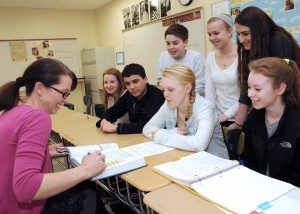Adventures in ‘Close Reading’: A Teacher Prepares for PARCC
PARCC exams help teachers focus on instruction that builds students’ real-world skills

By Christina Houstian
“All this?” asked Dana, a sophomore in my Advanced Placement (AP) U.S. Government class. “We have to read this?” Dana gasps at James Madison’s Federalist #10, a text written in the 18th century that covers nearly three pages, double-spaced.
I am moving between groups of students, distributing index cards, highlighters, and sticky notes, and trying to be reassuring as Dana’s ‘deer in the headlights’ look spreads across the room. They anxiously eye the text—key reading for understanding the birth of our nation’s system of government. Moreover, this primary source document is a mandatory assigned reading in the College Board’s curriculum for the course, so my students will need to understand and “own” it; they will refer back to it throughout the year as the basis for government decisions regarding the “tyranny of the majority.”
Reading for Meaning: A Fundamental Building Block
For most of these 10th graders, this is their first AP class, and their first taste of college. It is at once empowering and daunting for them to face a textbook as well as primary and secondary sources widely used for political science courses at the university level. They will need a great deal of support, especially in the first few months of the course, to build their confidence and give them the skills required to “own” this text, and many like it, in order to meet with success.
Throughout the year, my students will be using a skill called “close reading”—one of several skills addressed by the new Common Core standards and assessed by the PARCC tests. While it has become a buzzword in education, close reading, or the ability to closely read and analyze a text for meaning, is not new. It is simple, authentic literacy that serves as a fundamental building block for learning throughout high school, college, and beyond.
Questioning as They Go
Back in my classroom, I’ve distributed the tools for active close reading: index cards, highlighters and sticky notes. Before they begin reading, I introduce vocabulary they will encounter in the text. They highlight the terms, and jot meaning in their own words along the margins.
Then, I establish the purpose for reading. For example, in this reading, I instruct them to underline the text anywhere they find a reference to “factions,” and then write an annotation in the margin. Finally, I model higher-order reading and thinking, showing them how to produce questions about the reading as they go, writing them on the index cards, and sharing them with a partner.
After practicing how to tackle a challenging reading assignment together, they work in pairs, annotating, highlighting and questioning. Anywhere they see an idea that interests them, makes them wonder, or confuses them, they attach a sticky note, jotted with their thoughts, exclamation points, or question marks.
The Hands Go Up
Finally, we share our thoughts after reading. Hands go up across my room, as the students exchange ideas and ask questions. The reading becomes a springboard for a wider discussion on civil rights, interest groups, and the meaning of the word “tyranny.” Many students refer to their index cards, using them for support. Close reading is a way to promote active reading, to allow students the skills for ownership of a text.
Close reading is also a skill that these students are learning across the curriculum in high school, and the PARCC tests have provided teachers with a focused need for instruction that addresses close reading. My hope is that close reading will help my students to face any reading task with a positive, fearless approach.
For more information about PARCC and what it means for students and parents, visit www.marylandpublicschools.org and click on “Prepare for PARCC.”
Christina Houstian was the Anne Arundel County Teacher of the Year for 2014. She serves as the Social Studies Department Chair at Broadneck High School.